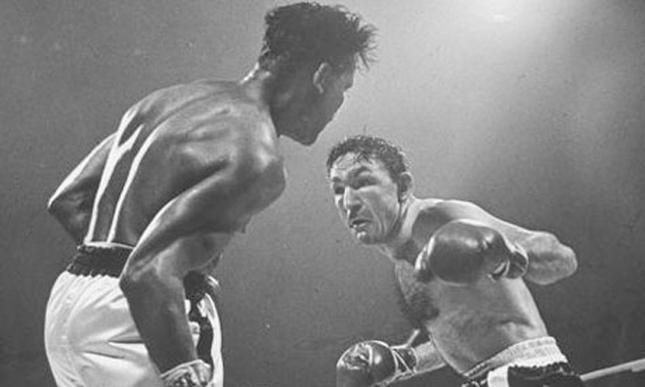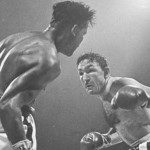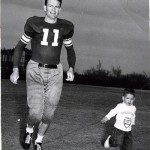Old-School Fighters: Royal, Basilio, From Football and Boxing
By • November 26, 2012 0 2963

In a country obsessed by sports—especially football—there’s been a lot of changes.
No one runs the wishbone formation much any more—at any level of football. There is no more Southwest Conference in college football. They ran it the other day for a play in a University of Texas game, honoring Darrell Royal, the legendary coach of Texas University of Texas at Austin, who invented the wishbone and succumbed to Alzheimer’s disease at the age of 88 Nov. 7.
In boxing—well, well, what can you say about boxing that’s worth saying? Russians hold the heavyweight title. There’s no Friday night fights on television, and mixed martial arts seems to be gaining ground on boxing’s fan base.
And Carmen Basilio, the lean, wiry keeps-on-ticking former welterweight and middleweight champion, who fought two memorable battles with Sugar Ray Robinson, is gone, dead at 85.
Hard to say what if anything Royal said about this year’s annual slugfest between the Texas Longhorns and Oklahoma Sooners—Bob Stoops’s Sooner Boomer swamped Texas 63-21. It’s fair to say that sort of thing wouldn’t have happened in Royal’s time—gritty running and tough defense were the hallmarks of Royal football. “You’ll never lose if the other guy doesn’t score” was one of the numerous and famous sayings attributed to Royal.
During his tenure—1957 through 1976—Royal rolled up ten Cotton Bowl Championships and three national titles, as well as holding a 12-7-1 edge over the Sooners in the Red River Rivalry. Football games under Royal tended to have a slugfest atmosphere about them—his favorite players were probably fullbacks and linebackers, who tended to meet head-on on the field.
He came late to integrating his teams, not having African-American players until 1969, a fact that he later regretted.
Still, Royal’s Longhorns rivaled the Dallas Cowboys in popularity and fan base—college football in places like Oklahoma and Texas tended to be bigger and sometimes more important than life itself—from Pop Warner to the pros. See “Friday Night Lights” for a references point, or read anything by Dan Jenkins (father of Sally) to get the feel of it.
Royal loved to play golf and coin phrases. His aversion to the pass—which he shared with Woody Hayes of Ohio State University—prompted him to say, “There are three things that can happen when you throw the ball, and two of them are bad.” He also described a runner as running faster “than gossip through a small town.”
Years ago—in the idyllic age of the 1950s—not only was high school and college football huge, but so was boxing at almost every level of the sport, but especially among the heavies where Rocky Marciano retired unbeaten in spite of Archie Moore. Among the welterweights and middleweights Sugar Ray Robinson ruled.
Until he ran into Carmen Basilio, a tough Italian fighter—and “fighter” is the word—out of Canastota, N.Y. Basilio and Robinson fought two brutal fights—there’s a picture of Basilio after winning the first fight on a decision and he looks as if a pickup truck had fallen on his face. The second fight was won by Robinson, a swirling almost elegant fighter with a knockout punch known for his graceful sparring—there was only one Sugar Ray, in spite of Sugar Ray Leoanard.
Back in the 1950s, I used to watch something called “Friday Night Fights” on network television with my stepfather, a Serbian immigrant who worked in a steel factory. We listened to the familiar Gillette commercial bells, as Gene Fullmer, Basilio, Bobo Olsen, Tony Demarco and others would knock each other silly. The welters and middleweights were filled with normal-sized boxers, wiry and tough, like Jake LaMotta (of “Raging Bull” fame), who could take punishment and dish it out.
That was Basilio to the core—he pummeled DeMarco into submission twice in welter title fights, then lost to Fullmer. Basilio didn’t just win his fights—he survived them.
Thirty thousand people saw Basilio beat Robinson at Yankee Stadium. His dad, an onion farmer in upstate New York was a “fight nut.” His son became one, beginning with boxing in the Marine Corps. He eventually retiring, teaching physical education at Le Moyne College in Syracuse. A high school dropout, he received a diploma from Canastota High school in 2009 in recognition of his achievements. He was among the first inductees in the International Boxing Hall of Fame.
- Carmen Basilio, right, in the ring with Sugar Ray Robinson in 1958.
- Mack Royal



